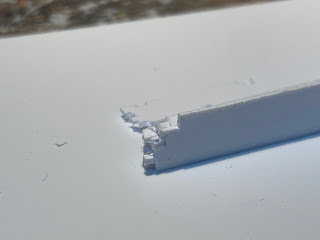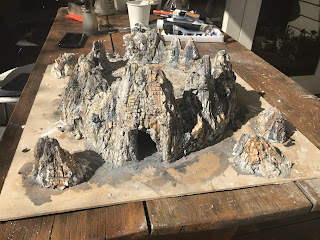Wednesday, 8 May 2024
Backs (or flank) against the wall, Heavenfield, 633 CE
Friday, 2 September 2022
Split rail fences for 2mm ACW
Felling the timber, splitting it into rails and stacking it along your farm boundaries must have been a punishing task in the 19th century.
Punishing, in a very different way, is an apt description for scratch building split rail (snake) fencing for my 1:800 (eg. 2mm) ACW terrain!
I have to admit these little guys spent more time stuck to my fingers than to their bases. Nevertheless, the struggle yielded the equivalent of 14 chains (chain = 22 yards) of fencing for Wilmer McLean’s farm.
The method, while fiddly, is fairly strait forward.
I cut a series of 50mm x 1mm strips (sorry, back to metric for this) of 0.5mm Evergreen Styrene sheet which was scored every 5mm on opposite sides.
I then bent each scored point to form a zigzag long enough for my bases. This was attached to the base (via being glued to various fingertips) using Superglue. Then 5mm lengths were scored in the centre and bent into a right angle piece using tweezers. These were glued to the outward facing points of the fence to represent the crossed over rails.
The roughed up 45mm x 10mm base of styrene was coated carefully with fine sand (using PVA) and then undercoated with Vallejo grey primer (73.601). I washed the dry undercoat with Liquitex raw umber acrylic ink. Then, I painted the fence rails dark brown. These were dry-brushed with Army Painter Drake Tooth. My flower meadow mix of flocking was glued in place then a light coat of Vallejo Mecha Dark Rust wash (a staple in my paint collection) was applied on the rails. Done!
These simple 2mm terrain pieces add, I feel, some period flair to ACW battlefields at this scale. Maybe cornfields and a peach orchard next!
Saturday, 27 February 2021
Sci-fi crystal outcrop scatter terrain (scratch built)
Rocky outcrops seem to be a staple piece of scatter terrain for all sorts of skirmish gaming. I've wanted to try may hand at crafting crystal terrain for sci-fi gaming and role playing for some time. I have never tried any sci-fi skirmish gaming so I though this might kick-start that with a bit of cool and adaptable terrain.
Here is a quick summary of the project!
The The base structure is built out of 30mm and 50mm XPS insulation foam from Kanuf. I used the 30mm for the base and (a combination of both for the crystals.
The cutting was all done with a craft knife with a new blade so as to minimise tearing. The best result visually is achieved if you have an odd number of crystals per base and a range of sizes - I didn't always follow this rule, though! I used angled cuts with the knife to give texture to the edge of the base and to great some cracks in the crystals (see below).
Then, I applied a stone-like texture to all the surfaces (before gluing) with a ball of aluminium foil. The crystals were hot glued to the foam base and in some cases I used a toothpick to help reinforce the join.
The whole piece is then coated with a sealing coat of Matte Mod Podge with black acrylic paint. The mix is roughly made up as follows: 4 parts Matte Mod Podge to 1 part black acrylic paint. The ratio is not critical - just use what looks good to you. I left these to dry completely. It looks glossier in the picture below that it does in reality.
The first top coat is a dry brush with Mont Marte Emerald Green for their Dimensions acrylic paint range. You can use any cheap paint you like but I did find this colour was particularly good for this project. I left a fair bit of the black undercoat showing through - especially in the thicker sections of the 'crystals' to create a sense of shadow and lower opacity.Monday, 28 January 2019
A craggy protuberance
Tuesday, 9 October 2018
Scratch built Nissen Huts, road barriers and shipping container 28mm
 |
| 'The Road' (Source) |
Keeping to my (nearly) zero budget terrain philosophy, I have been working mostly with cardboard, cork and wire mesh. Here are a few of the creations and the inspiration for them.
 |
| 'The Base' - a quick layout of the components I have built so far. At the moment I'm working on roads, finishing the perimeter fence and helipads. |
 |
| I love the look of these old Nissen huts built using 90mm postal tube and corrugated cardboard. The construction process is set out in a great article by Dennis Berwick |
 |
| This bird's eye view of the base shows the mysterious generator spewing out toxic goop on the bottom right. Ultimately this will be outside the perimeter of the base. |
 |
| These street barricades are simple to make and will be useful for a range of modern settings. I used a cool tutorial by FearDaAlien. They just need some ballast in the bottom as, being made out of foam, they tend to fall over easily. |
 |
| I've wanted shipping containers for ages - always been looking in toy stores etc. At last, I've found a great tutorial on Panzerfaust Nostalgia for making them out of card. I'm very happy with the result. Now for mass production! The container made out of 1mm card stock with craft store corrugated cardboard glued to the outside and plastic tubing for the locking mechanism. |
Just as an aside, I found this nice little article on post-apocalyptic ecology: http://strangehorizons.com/non-fiction/articles/ecology-and-the-post-apocalypse/
Sunday, 22 April 2018
Sea mat - ready for action
I've had a sea mat half-made for some time and wanted to get it done to encourage me to return to some naval gaming. It's been some time since my 1:2400 Russo-Japanese War, Second Balkan War Ottoman and Greek fleets and WW1 ships have seen any action.
For this mat I used a dark grey caulk which provided a good base color. Over this I laid a wash of ultramarine blue then, after that dried, I picked up the texture with a dry-brush of off-white acrylic house paint. Once the paint was dry I applied an acrylic, semi-gloss clear sealant I purchased from an automotive supplies shop (for another job).
The result is a moody sea with a slight hint of reflection provided by the sealant (it was looking a little too matt without that). Someone with more patience than I would, no doubt, find the ideal method to provide the impression of the white caps on the waves. Perhaps using a sponge might have been the way to go?
For less than 2 hours work in total (not including drying time), I'm happy with the outcome and can't wait to get the ships out (well, I already have, as you will see!).
Update 22/04/18
The mat will be good for my air war over the Falklands project too.
 |
| Argentine Mirages send some 'hot stuff' towards a Vulcan bomber and its escort. |
Saturday, 10 June 2017
Ottoman fort for V-Beach
Tonight , I finished a very quick scratch guild (in cork) of a small, rather generic, Ottoman fort that will act at Ertogharal Fort sitting above the low cliffs at the west end of V-Beach. The above map suggests the fort was largely a gun emplacement so I'm looking into converting it to include some large naval guns to give the right feel.
However I've kept it pretty generic as I want to use if for my other ITLSU scenarios in Palestine and Mesopotamia. And who knows when I might need a fort in Belgium for some Western Front action!










































